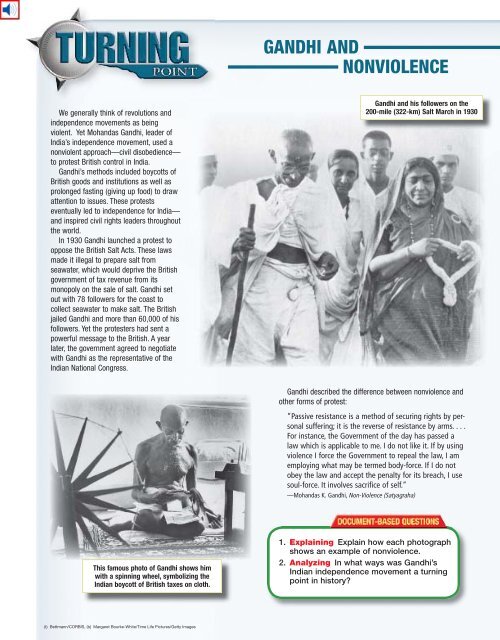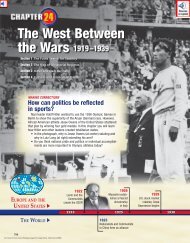GANDHI ANDNONVIOLENCEWe generally think of revolutions andindependence movements as beingviolent. Yet Mohandas Gandhi, leader ofIndia’s independence movement, used anonviolent approach—civil disobedience—to protest British control in India.Gandhi’s methods included boycotts ofBritish goods and institutions as well asprolonged fasting (giving up food) to drawattention to issues. These protestseventually led to independence for India—and inspired civil rights leaders throughoutthe world.In 1930 Gandhi launched a protest tooppose the British Salt Acts. These lawsmade it illegal to prepare salt fromseawater, which would deprive the Britishgovernment of tax revenue from itsmonopoly on the sale of salt. Gandhi setout with 78 followers for the coast tocollect seawater to make salt. The Britishjailed Gandhi and more than 60,000 of hisfollowers. Yet the protesters had sent apowerful message to the British. A yearlater, the government agreed to negotiatewith Gandhi as the representative of theIndian National Congress.Gandhi and his followers on the200-mile (322-km) Salt March in 1930C<strong>25</strong>-13P-8745<strong>25</strong>Gandhi described the difference between nonviolence andother forms of protest:“Passive resistance is a method of securing rights by personalsuffering; it is the reverse of resistance by arms. . . .For instance, the Government of the day has passed alaw which is applicable to me. I do not like it. If by usingviolence I force the Government to repeal the law, I amemploying what may be termed body-force. If I do notobey the law and accept the penalty for its breach, I usesoul-force. It involves sacrifice of self.”—Mohandas K. Gandhi, Non-Violence (Satyagraha)This famous photo of Gandhi shows himwith a spinning wheel, symbolizing theIndian boycott of British taxes on cloth.1. Explaining Explain how each photographshows an example of nonviolence.2. Analyzing In what ways was Gandhi’sIndian independence movement a turningpoint in history?(t) Bettmann/CORBIS, (b) Margaret Bourke-White/Time Life Pictures/Getty Images
Myrleen Ferguson Cate/PhotoEditA Militarist JapanBy the late 1920s, militant forces inJapan were campaigning for an end to peacefulpolicies.HISTORY & YOU Do you own anything made bySony, Mitsubishi, or Toshiba? Read to learn how Japandeveloped its modern industrial economy.Japanese society developed along aWestern model. The economic and socialreforms launched during the Meiji Era ledto increasing prosperity and a modernindustrial and commercial sector.A Zaibatsu EconomyIn the Japanese economy, various manufacturingprocesses were concentratedwithin a single enterprise called thezaibatsu, a large financial and industrialcorporation. These vast companies controlledmajor segments of the Japaneseindustrial sector. By 1937, the four largestzaibatsu (Mitsui, Mitsubishi, Sumitomo,and Yasuda) controlled 21 percent of thebanking industry, 26 percent of mining,35 percent of shipbuilding, and over 60percent of paper manufacturing andinsurance.The concentration of wealth led to growingeconomic inequalities. City workerswere poorly paid and housed. Economiccrises added to this problem. After WorldWar I, inflation in food prices led to foodriots. A rapid increase in population led tofood shortages. (The population of the Japaneseislands increased from 43 million in1900 to 73 million in 1940.) Later, when theGreat Depression struck, workers andfarmers suffered the most.With hardships came calls for a return totraditional Japanese values. Traditionalistsespecially objected to the growing influenceof Western ideas and values on Japaneseeducational and political systems. At thesame time, many citizens denounced Japan’sattempt to find security through cooperationwith the Western powers. Instead, theydemanded that Japan use its own strengthto dominate Asia and meet its needs.American teenagers shopping forelectronics at a mall in CaliforniaDuring Japan’s Meiji Era, family-controlled conglomerates known as zaibatsubegan to form. By the time World War II began, four zaibatsu controlled much ofJapan’s banking, trade, and heavy industry. The Japanese government aided thegrowth of the zaibatsu by granting monopolies and special privileges in return fortheir help with government projects.After World War II, the Allies broke up the zaibatsu. In the 1950s, however, newgroups called keiretsu formed, based on the old zaibatsu and often retainingtheir old names. By pooling their resources, the keiretsu helped make Japana global economic power. Today, Japanese keiretsu such as Mitsubishi,Mitsui, and Fuyo produce brands popular around the world.• Mitsubishi: Mitsubishi Electric, Mitsubishi Motors• Mitsui: Fuji, Toshiba, Toyota• Fuyo: Canon, Hitachi, Yamaha, Nissan, Ricoh 1. Analyzing What advantages aided the growth of thezaibatsu and keiretsu into powerful corporations?2. Identifying Name three products made by Japanesekeiretsu that are commonly sold in the United States.



